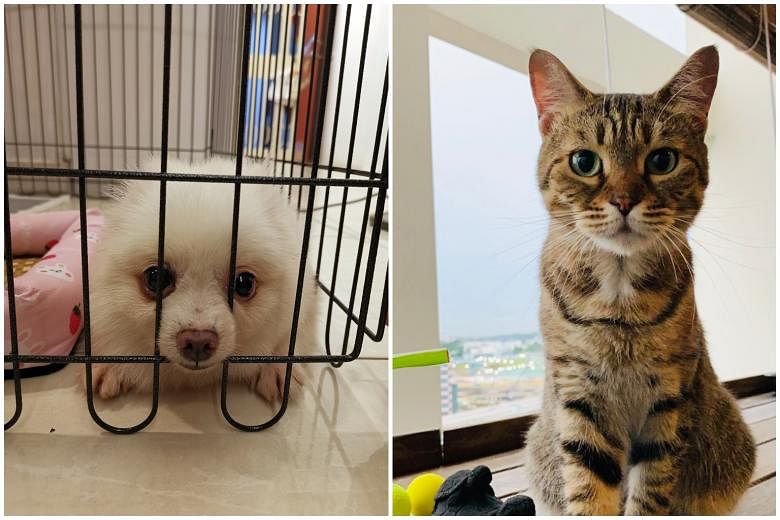In this fortnightly column, veterinarians from the National Parks Board answer questions about pet health and behaviour.
Regular health checks vital for pets
I recently adopted a former breeding dog. I took her to a veterinarian for a general check-up and was told that she is fine. However, I did not get a blood test done for her.
I would like to know what I should look out for in my pet. Although she is nearly five years old, she is not pee-pad-trained. Is it possible for her to be trained at this age? Her meals at the breeding farm consisted mainly of chicken. I have been feeding her pork, beef or fish instead. Her bowel habits are now also irregular. Could it be due to changes in her diet?
Geraldine Ong
Regular health check-ups are important for pets as they are unable to articulate when they are not feeling well.
Diagnostic tests such as blood tests are important as they help your vet to assess symptoms that cannot be seen or felt, such as indicators of liver or kidney disease.
Routine blood testing can also reveal useful information about your pet's state of health.
In healthy pets, blood test results help to establish a "normal baseline", which is useful in interpreting potential changes in the health of pets should they fall ill. Routine blood tests can also pick up underlying problems, which your vet can treat before they escalate.
It is recommended that pets undergo yearly health checks. Customised health-check plans can be formulated based on the individual pet's needs.
Dogs can be house- or toilet-trained at an adult age, but the length of training time needed varies. Like other training regimens or programmes, toilet training a dog requires time, patience and dedication.
A routine must also be agreed on and strictly adhered to by the caregivers to maximise consistency and increase chances of success.
Changes in diet may result in changes in faecal volume, output and appearance. Change your pet's diet gradually, over a period of seven to 10 days.
For dietary changes and routine health monitoring, it is best to consult your vet.
Fur flying when felines face off
I adopted a short-haired domestic cat called Drizzle, who is more than two years old, in March after she was rescued from a canal. She has undergone emergency surgery on her broken hind leg. She is very aggressive towards my other cat Juno, a mixed Siamese who is more than four years old. Juno also tends to provoke Drizzle with her loud hisses.
A couple of encounters left Juno slightly injured. For now, I keep them in separate rooms. I am afraid Juno will be badly injured as Drizzle is younger, bigger and stronger. How can I get them to live in harmony?
Josephine Tan
Cats are territorial and it can be difficult to introduce a new cat into an established cat's territory, even when that "territory" is your home.
It can take close to 12 months or longer for cats to develop a friendship with a new furry companion.
Introducing a new cat into your home must be done gradually, as it is stressful for both cats. They will require time to settle and adjust to changes in their environment.
Separating the cats in different rooms is a good start - this gives both areas where they feel safe. Each pet should have its own food and water bowl, litter box, scratching post and bed.
One possible way of gradually introducing both cats is to feed them near a door that separates them, so they can smell and hear each other through the door.
If this does not result in signs of aggression over a period of time, such as a few weeks, a potential next step would be to introduce their scents by switching the cats' belongings and locations so they can "investigate" each other's smell.
Face-to-face introduction of the cats can then be carried out under close supervision for short periods. Then, gradually increase the amount of time the cats are exposed to each other.
If the cats display signs of aggression, revert to the previous step and do not continue until you observe no further aggression.
Eventually, if the two cats are able to live peacefully together, their resources should still be separated to reduce competition and allow them to distance themselves from each other if preferred.
Unfortunately, it is not possible to predict whether the cats will get along, as this is largely dependent on their individual personalities.
In some situations, it may be necessary to keep the two cats permanently separated or rehome one of them. In the long run, that may also be better for the cats' general welfare as they will not be subject to chronic stress and tension, which could lead to health issues.
Any sudden change in your cats' behaviour could be an indication of an underlying medical condition. If you notice unusual physical or behavioural symptoms, or if either cat stops eating, see your veterinarian immediately.
- Answers by Dr Grace Yam, a veterinarian from the Animal & Veterinary Service under the National Parks Board.
Write in
Have a query about your pet? Write in with clear, high-resolution pictures of at least 1MB of your pet as well as include details about its age and breed. E-mail them with your full name to stlife@sph.com.sg. We reserve the right to edit and reject questions.

